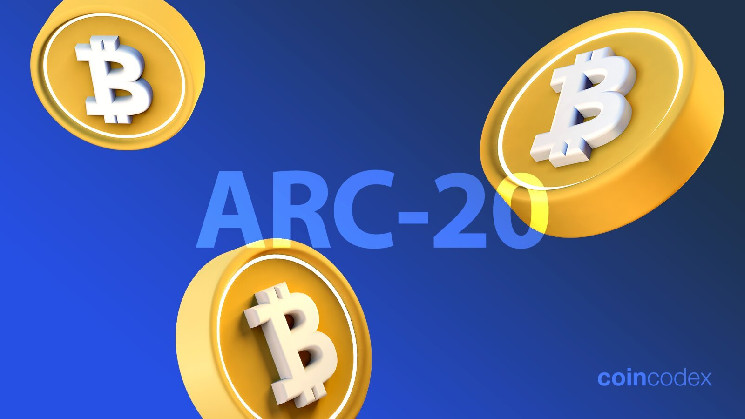ARC-20 is a token standard that makes it possible to create fungible tokens that can be held and transferred on the Bitcoin blockchain. ARC-20 standard tokens are issued using the Atomicals protocol. In the ARC-20 standard, tokens are represented with satoshis, which are the native unit of the Bitcoin blockchain (1 BTC consists of 100 million satoshis).
ARC-20 is a fungible token standard for Bitcoin
The concept of fungible tokens was popularized in the cryptocurrency space by Ethereum, where they are typically issued using the ERC-20 standard. Certain ERC-20 tokens have achieved massive market capitalizations – some of the biggest fungible tokens on the market today include UNI, SHIB, LDO, and, of course, stablecoins.
The ability to mint fungible tokens is available on practically every blockchain platform that has general-purpose smart contracts. For example, there are fungible tokens on Solana (SLP tokens), BNB Chain (BEP-20 tokens), Cardano (native tokens), and so forth.
While Bitcoin’s smart contracts capability is a lot more limited, developers have come up with creative ways to represent different types of digital assets (fungible and non-fungible tokens) on the Bitcoin blockchain.
The ARC-20 token standard is enabled by the Atomicals Protocol, which is a way to create both fungible and non-fungible tokens on Bitcoin. The Atomicals team refers to the digital assets that can be created through the protocol as “digital objects”.
Minting ARC-20 tokens
Anyone can create an ARC-20 token and determine its supply, ticker and metadata (for example official website, social media links and an image). However, since each ARC-20 token is represented by 1 satoshi, there is actually a pracitcal limit to how many ARC-20 tokens someone can mint.
This is different from the ERC-20 standard for example, where you can make a token’s supply as big as you want for no additional cost while you’re creating it. For example, many meme coins issued on blockchains such as Ethereum have a supply of hundreds of trillions of tokens.
The process of minting ARC-20 tokens and its implications on token supply are arguably the most unique aspect of ARC-20 tokens when compared to other fungible token standards in use today, so let’s explain it in a bit more detail.
Decentralized ARC-20 token minting
The decentralized ARC-20 token minting mode allows the creator of the token to specify how many mints of the token are allowed, and how many tokens are issued in one mint. By itself, this doesn’t create any tokens, but users who want the token can mint them.
Direct ARC-20 token minting
In the direct minting mode, the user creating the ARC-20 token creates an output that contains the total supply the token. For example, if you want to create a token with a supply of 10 million with the direct minting mode, you need to create an output of 10 million satoshis (0.1 BTC). The more tokens you want to mint, the more BTC you need to provide.
How to use ARC-20 tokens?
In order to hold and transact with ARC-20 tokens, you need a Bitcoin wallet that supports UTXO selection, also known as “coin control”. Here are a few examples of such wallets:
- Sparrow
- Electrum
- Mycelium
- Blue Wallet
- Ledger Live
ARC-20 vs. BRC-20 – Atomicals and ordinals compared
ARC-20 tokens perform a similar function to BRC-20 tokens, which are also fungible tokens on the Bitcoin network, except they’re issued through the Ordinals protocol.
Although Atomicals and Ordinals provide very similar utility, the two protocols do differ in some areas. Notably, Ordinals must be used with Taproot addresses for all use cases. Atomicals require the use of Taproot addresses for minting and updating assets, but not for transferring them.
Fungible tokens are not supported in the base Ordinals protocol, while Atomicals implement them as the first-class ARC-20 standard. The Atomicals protocol also supports two distinct types of minting fungible tokens.
Another difference is that Ordinals does not have a name service in the base protocol. Meanwhile, Atomicals features a name service which is implemented through first-class NFTs called Realms.
To sum up, we can say that the Atomicals protocol offers a broader feature set than Ordinals, but the Ordinals protocol has seen more adoption so far. To be fair, the Ordinals protocol has benefited from a head start, as it was launched in January of 2023, while the Atomicals protocol was released in September of 2023.
At the moment, the Ordinals protocol is a lot more popular than the Atomicals protocol, although Atomicals have been gaining some traction. In total, Atomicals protocol transaction have generated around 274 BTC in fees, while Ordinals protocol transactions have generated 4,050 BTC in fees.
If you want to see a comparison between Ordinals and Atomicals based on on-chain activity, you can check out this helpful Dune Analytics dashboard that compares the two protocols.
The bottom line
ARC-20 tokens are fungible tokens issued on the Bitcoin blockchain using the Atomicals Protocol. When ARC-20 tokens are minted, each token is represented with a satoshi, which is the smallest unit of BTC.
In terms of functionality, ARC-20 tokens are fairly similar to BRC-20 tokens, which are issued using the Ordinals protocol. Currently, the Ordinals protocol is more popular than the Atomicals protocol, but the Atomicals protocol provides some extra features which could help it gain more adoption.
If you want to learn more about Bitcoin, take a look at our article explaining how Bitcoin wallet addresses work.
Read the full article here

